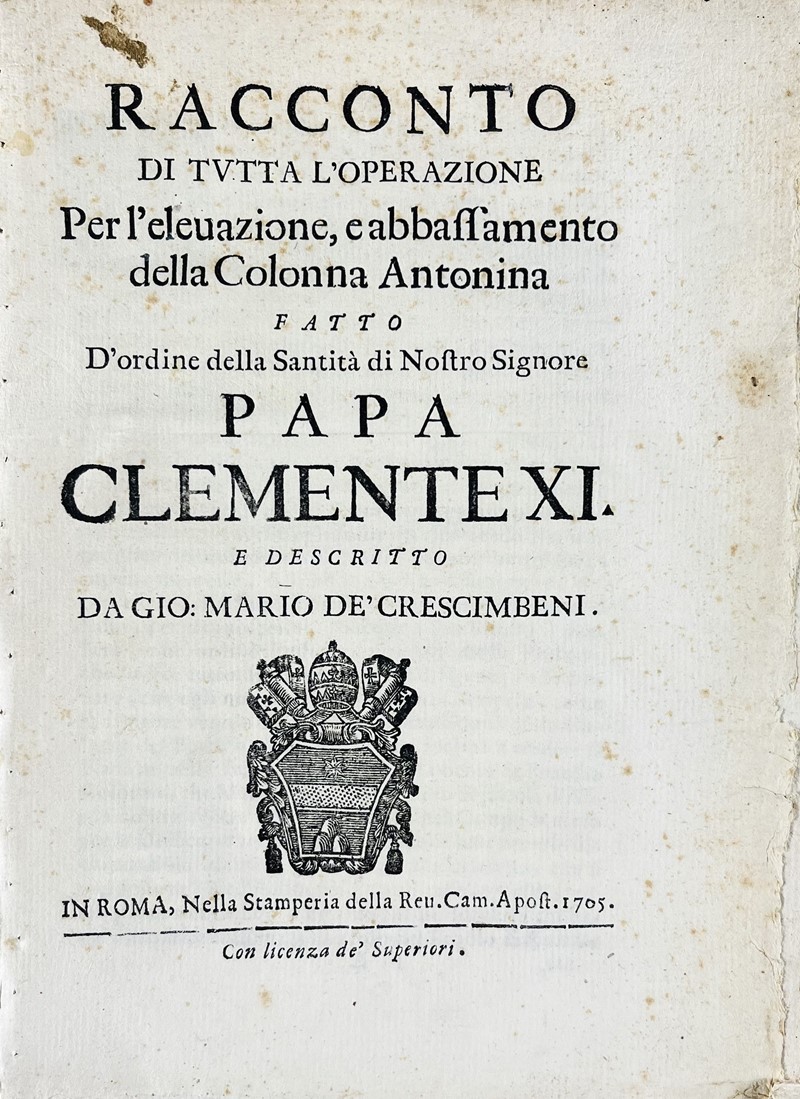
98
Engineering - Architecture. DE' CRESCIMBENI. Racconto di tutta l’operazione per l’elevazione, e abbassamento della Colonna [..]
1705
EUR 300,00
Base d'asta
EUR 500,00 / 600,00
Stima
Descrizione
Engineering - Architecture. DE' CRESCIMBENI. Racconto di tutta l’operazione per l’elevazione, e abbassamento della Colonna [..]
1705
1705
DE’ CRESCIMBENI, Giovanni Mario. Racconto di tutta l’operazione per l’elevazione, e abbassamento della Colonna Antonina fatto D’ordine della Santità di Nostro Signore Papa Clemente XI e descritto da Gio: Mario De’ Crescimbeni.
In Roma, Nella Stamperia della Rev. Cam. Apost., 1705
4to; 235x170 mm.; Pp. 27, [1 bianca], (A-B4, C6), stemma xilografico al frontespizio, iniziale xilografica. Slegato, come da edizione, con leggere tracce dovute alla presenza pregressa di legatura. Lieve foxing al frontespizio e nei margini. Bella copia in barbe, parzialmente intonsa.
Resoconto delle operazioni eseguite nel 1705 per sollevare la Colonna di Antonino Pio e abbassarla su rulli.
Rinvenuta nel 1703 nel giardino dei Padri della Missione in Campo Marzio durante la demolizione di alcune case, la colonna fu inizialmente scambiata per la Colonna citatoria ma presto identificata con la colonna di Antonino Pio. La colonna, realizzata in granito rosso egiziano, fu eretta tra il 161 e il 162 in onore dell'imperatore Antonino Pio e di sua moglie Faustina.
Clemente XI decise di spostare la colonna; fu formata una commissione e i lavori furono affidati all'architetto Domenico Fontana e a suo figlio Francesco. Ridley: “One of the most remarkable stories in the history of Roman archaeology, ... is the story of the extraction of the column of Antoninus Pius in the Campus Martius (1703-5). The work was placed in the hands of the ‘noble” architects Carlo and Francesco Fontana, instead of competent engineers, and the result was the destruction of the column.”
Dopo alcuni tentativi falliti, nel 1704 la colonna fu finalmente sollevata e abbassata su rulli, pronta per essere spostata in piazza Montecitorio. Qui termina il resoconto di Crescimbeni.
Il piano, tuttavia, si risolse in un disastro e la colonna fu gravemente danneggiata, presumibilmente già in epoca antica ma in realtà perché il compito era stato mal pianificato e ancor peggio eseguito; un successivo incendio non ne migliorò le condizioni.
I frammenti della colonna sono ora custoditi nei Musei Vaticani a Roma.
R.T. Ridley, The fate of the column of Antoninus Pius In: Papers of the British School at Rome 2018, pp. 235-269 (abstract); Giulio Natal,i Crescimbeni, Giovanni Mario In Enciclopedia Italiana 1931.
Condition Report
4to; 235x170 mm.; Pp. 27, [1 blank]. (A-B4, C6), woodcut coat-of-arms on title page, woodcut initial. Disbound, as issued, but with traces of having been in a binding for some time. Slight foxing on title page and on the margins. Good untrimmed copy, partially uncut.
Account of the operations performed in 1705 to raise the Column of Antoninus Pius and to lower it onto rollers. Found in 1703 in the garden of the Mission Fathers in Campus Martius during the demolition of some houses, the column was initially mistaken for the Colonna citatoria but soon identified with the column of Antoninus Pious. The column, made of Egyptian red granite, was erected between 161 and 162 in honor of the emperor Antoninus Pius and his wife Faustina.
Clement XI decided to move the column, a commission was formed and the work entrusted to the architect Domenico Fontana and his son Francesco. Ridley: ““One of the most remarkable stories in the history of Roman archaeology, ... is the story of the extraction of the column of Antoninus Pius in the Campus Martius (1703-5). The work was placed in the hands of the ‘noble architects Carlo and Francesco Fontana, instead of competent engineers, and the result was the destruction of the column.””
After some failed attempts in 1704 the column was finally raised and lowered on rolls, ready to be moved to Montecitorio square. Here ends Crescimbeni’s report. The plan, however, ended in disaster and the column was badly damaged, allegedly already in ancient time but actually because the task was badly planned and even worst performed; a later fire didn’t improve its condition.
The fragments of the column are now kept in the Vatican Museums in Rome.
Bibliografia
R.T. Ridley, The fate of the column of Antoninus Pius In: Papers of the British School at Rome 2018, pp. 235-269 (abstract); Giulio Natal,i Crescimbeni, Giovanni Mario In Enciclopedia Italiana 1931.
mer 4 Dicembre 2024
Orari Asta
Bado e Mart Auctions
Via dei Soncin, 28
35122 Padova
ESIBIZIONE: 29 Novembre-2 Dicembre 2024 solo su appuntamento.
Per prenotare il vostro appuntamento chiamare il numero 049 8755317 o mandare una email a info@badoemart.it
Ricordiamo che il nostro staff rimane a vostra disposizione per eseguire condition report dettagliati con foto aggiuntive a quelle già presenti in catalogo.

